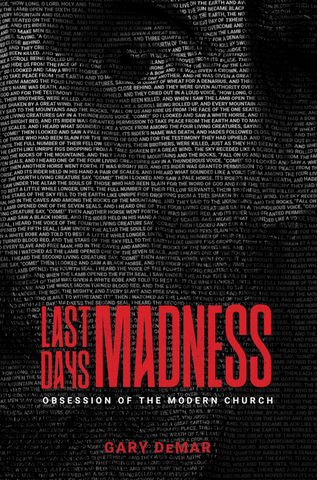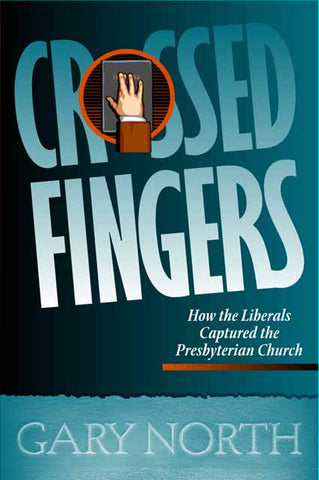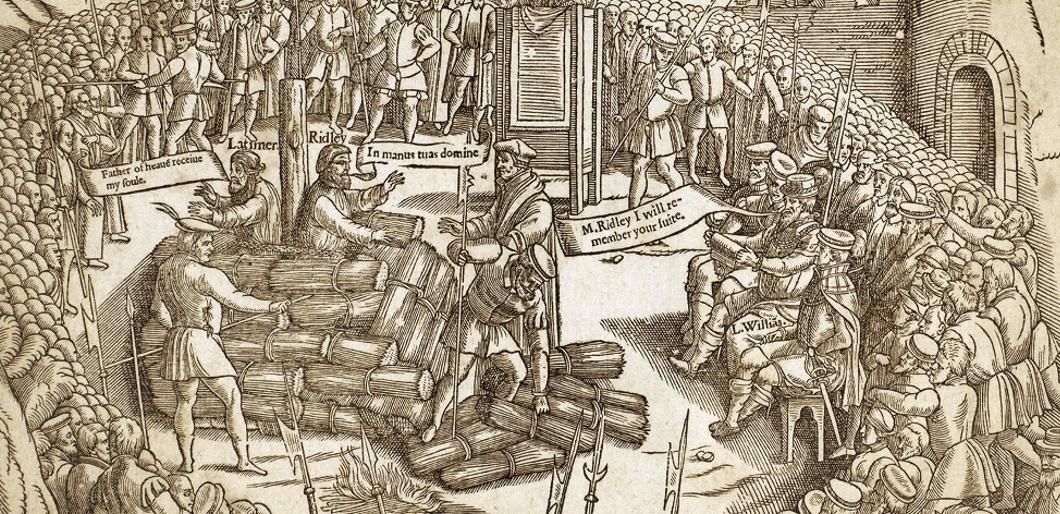How authoritative are man-man confessions of faith? Can they ever be revised or updated? How sacrosanct is historical theology? No one should despise the work of the church over its many centuries or the work it has produced over nearly two millennia. My many published works show great respect for historical works. In some circles, when there’s a disagreement, appeals are made to agreed-upon seemingly unimpeachable sources like creeds that often do not offer scriptural support for a doctrine or confessions that offer passages that do not support what they claim or neglect to deal with some important biblical topics. As a result, the definition of “orthodoxy” based on confessions of faith in particular ends up discouraging any reevaluation of a doctrine like eschatology over which there are often numerous “orthodox” positions where there are wide chasms of disagreements.

Last Days Madness
In this authoritative book, Gary DeMar clears the haze of "end-times" fever, shedding light on the most difficult and studied prophetic passages in the Bible, including Daniel 7:13-14; 9:24-27; Matt. 16:27-28; 24-25; Thess. 2; 2 Peter 3:3-13, and clearly explaining a host of other controversial topics.
Buy NowLet’s consider the Reformation doctrine that the papacy was/is the biblical antichrist (there have been other revisions). It was so assured that it was written into the Westminster Confession of Faith (WCF) (1647) at Chapter 25 section 6:
There is no other head of the church but the Lord Jesus Christ. Nor can the pope of Rome, in any sense, be head thereof: but is that Antichrist, that man of sin, and son of perdition, that exalteth himself, in the Church, against Christ and all that is called God.
This opinion was nearly universal coming out of the Reformation. The 1560 Geneva Bible was a product of the Reformation. John “Calvin and the marginal notes to the Geneva Bible” identified the antichrist and the man of sin, “this adversary” and “the mystery of iniquity … with the Papacy… In the Geneva notes the first Beast [in Revelation 13] is defined as the Roman Empire. The Second Beast has swallowed up all authority of the first,” as Christopher Hill notes.[1]
Antichrist, the Beast, was not merely the Pope as a person, however, but the papacy as an institution which subsumed within itself all the evil, coercive, repressive aspects of the secular [Roman] Empire [according to the note on Revelation 13:16-17]: ‘a most wicked and most insolent tyranny … usurped over the persons of men … and over their goods and actions.’[2]
To object to this view was paramount to denying the Reformation. In the American colonies, Increase Mather (1639-1723), following the Reformers, was an ardent supporter of the papal antichrist view, but his son Cotton Mather (1663-1728) rejected it. At the time, writers like Hugo Grotius (1583-1645), Henry Hammond (1605-1660), and Richard Baxter (1615-1691) had also rejected the papal antichrist/man of sin view. Opposition was fierce as Increase Mather’s denouncement shows:
As for Grotius, I took on my self as concerned to warn young Scholars to beware of him, lest they suck down poison when then think they have found Honey. He has (as Dr. Owen in his Answer to Biddle has made to appear) by perverse Expositions and Interpretations in his Annotations on the Bible, corrupted many Texts of Scripture…. [and] That Dr. Hammond[3] has borrowed most of his Notions from Grotius (especially his Apocalyptical ones) whoever compares them will quickly discern.[4]
What did the Reformers get wrong? The (1) biblical definition of an antichrist, (2) the number of antichrists, and (3) the timing of these antichrists that are found in the only texts where the word antichrist is used (1 John 2:18, 22; 4:1-3; 2 John 7). Curiously, the prooftexts used to support the view that the Pope was/is the antichrist do not include the only verses that use the term.[5] The same applies to 2 Thessalonians 2 concerning the timing of the “man of sin”/“man of lawlessness,” the “son of perdition” (ὁ υἱός τῆς ἀπωλείας, ho huios tēs apōleias) (2 Thess. 2:3; John 17:12): “you [Thessalonians] know what restrains him now” (2 Thess. 2:6-7).
Many published works identifying the Papacy as the antichrist almost never begin their assessment by referencing the only verses in the Bible that use the word antichrist (ἀντίχριστος/antichristos). This is true of Samuel J. Cassel’s Christ and Antichrist or Jesus of Nazareth Proved to be The Messiah and the Papacy proved to be the Antichrist (1846) and The Novelty of Popery and the Antiquity of the Religion of Protestants Proved by Scripture and History that “consists of a series of discourses, on the principal errors of Popery, styled the ‘Cripplegate Lectures,’ which were delivered by eminent English divines, in and near London , about the end of the seventeenth century” (iv) and published in 1840. In the “Seven Propositions” listed in the latter book, none of the biblical passages that use the word ἀντίχριστος/antichristos are found. The critiques of the Roman Catholic church are sound, but the ἀντίχριστος/antichristos is misapplied.
Is it possible that those who attended the Westminster Assembly were so fixated on the Roman Catholic Church as the ecclesiastical and political enemy (which it was) that they neglected the obvious preterist elements found in the New Testament because to deal with them definitionally, audience related, number, and timing would muddy the waters in identifying the Papacy as the antichrist? Gary North writes:
Since the days of Foxe’s Book of Martyrs (Acts and Monuments of These Latter and Perillous Days, 1563), there had been an almost universal belief in England that Protestants, under a godly king and (said the Anglican bishops) a godly episcopacy, would rout the Antichrist, meaning the Roman Church.[6] This apocalyptic expectation was appropriated by the Puritans in the late 1630’s and early 1640’s…. Parliament called into existence the Westminster Assembly in mid-1643 in earnest and apocalyptic expectation that this Assembly would speedily provide the theological and judicial framework for the true Church to fulfill the Book of Revelation.[7]
A preterist interpretation of NT prophetic passages would have weakened the argument that the Roman Catholic Church was the Man of Sin, the Antichrist, and the Beast and Harlot of Revelation.
The WCF 25:6 was revised in the 18th century in the American Version that now reads:
There is no other head of the church but the Lord Jesus Christ. Nor can the pope of Rome, in any sense, be head thereof.
This revision did not mean the Roman Catholic Church had changed its fundamental beliefs that the Pope was considered to be the “‘Vicar of Jesus Christ,’ meaning that he acts as Christ’s representative, ruling as the supreme head of the church on earth” and serves as “‘Pontifex Maximus,’ meaning supreme or great high priest (Lev. 21:10, Vulgate)” when “the Bible says our great high priest is Jesus, the Son of God (Heb. 4:14). Even today, “[i]nvoking the authority of Peter, the Pope claims to speak infallibly on matters of faith or life, placing his own words on the level of the words of Christ.”[8]

Crossed Fingers
Crossed Fingers is the first book to identify and discuss in detail the five points of liberalism and the rival theological positions. It is also the first published book that "follows the money" by tracing the sources of the funding of theological liberalism in twentieth-century America. One man, more than any other, was the primary source: John D. Rockefeller, Jr.
Buy NowDefinitionally, however, these do not fit the timing, era, audience, and number of the biblical antichrists who were alive in John’s day. The doctrines of the Roman Catholic Church can be evaluated in terms of a theological study of the New Testament, beginning with justification and Sola Scriptura, two fundamental doctrines that the earliest creeds do not address.
On the preterist debate, neither the creeds nor the Westminster Confessional Standards make any distinction between the near, soon, about to be, this generation coming of Jesus and the Second Coming. It’s long past time to deal with this fundamental issue.
[1]Ralph Woodrow, Great Prophecies of the Bible (Riverside, CA: Ralph Woodrow Evangelistic Association, 1971), 182-195.
[2]Christopher Hill, Antichrist in Seventeenth-Century England (London: Oxford University Press, 1971), 4-5.
[3]Hammond’s Paraphrase and Annotations Upon All the Books of the New Testament, published in 1653 “contained a brave but lonely attempt to introduce the preterist interpretation of the Book of Revelation to English soil. Hammond laid great stress on the opening words of the Apocalypse in which the book is said to contain ‘things which must shortly come to pass.’… But those who argued for the preterist interpretation of the Book of Revelation, were playing to empty galleries, until at least the fourth decade of the nineteenth century. Their views were anything but popular and those who followed them could soon find themselves branded with the infamous mark of the papal beast.” David Brady, The Contribution of British Writers between 1560 and 1830 to the Interpretation of Revelation 13.16-18: (the Number of the Beast): A Study in the History of Exegesis (Tübingen: J.C.B. Mohr P. Siebeck, 1983), 157-158.
[4]Increase Mather, A Dissertation Concerning the Future Conversion of the Jewish Nation Answering the Objections of the Reverend and Learned Mr. Baxter, Dr. Lightfoot, and Others: With an Enquiry into the First Resurrection (London, 1790), 8: https://bit.ly/3GZRts5
[5]These are the prooftexts used: Matthew 23:8, 9, 10; II Thessalonians 2:3, 4, 8, 9; Revelation 13:6.
[6]William M. Lamont, Godly Rule: Politics and Religion, 1603-60 (London: Macmillan, 1969), chaps. 1-3.]
[7]Gary North, Crossed Fingers, How the Liberals Captured the Presbyterian Church (Tyler, TX: Institute for Christian Economics, 1996),, 979.
[8]Joel Beeke, https://www.reformation21.org/confession/2013/07/chapter-256.php

